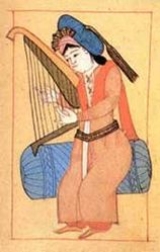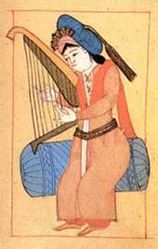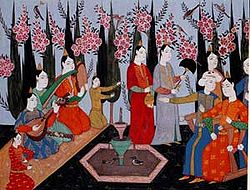
Çeng
Encyclopedia
- Not to be confused with CEngÇengThe çeng is a Turkish harp. It was a popular Ottoman instrument until the last quarter of the 17th century.The word comes from the Persian word "chang," which means "harp" ....
(the post-nominalPost-nominal lettersPost-nominal letters, also called post-nominal initials, post-nominal titles or designatory letters, are letters placed after the name of a person to indicate that the individual holds a position, educational degree, accreditation, office, or honour. An individual may use several different sets of...
for Chartered Engineer).


Harp
The harp is a multi-stringed instrument which has the plane of its strings positioned perpendicularly to the soundboard. Organologically, it is in the general category of chordophones and has its own sub category . All harps have a neck, resonator and strings...
. It was a popular Ottoman
Ottoman Empire
The Ottoman EmpireIt was usually referred to as the "Ottoman Empire", the "Turkish Empire", the "Ottoman Caliphate" or more commonly "Turkey" by its contemporaries...
instrument until the last quarter of the 17th century.
The word comes from the Persian
Persian language
Persian is an Iranian language within the Indo-Iranian branch of the Indo-European languages. It is primarily spoken in Iran, Afghanistan, Tajikistan and countries which historically came under Persian influence...
word "chang
Chang
- Groups of people :* Chang , a Chinese surname* Chang Naga, a tribe of Tuensang, Nagaland, India- Individuals :* Chang , a Korean surname* Chen Chung Chang, mathematician* Edmond E...
," which means "harp" (and also "five fingers").

Ottoman Empire
The Ottoman EmpireIt was usually referred to as the "Ottoman Empire", the "Turkish Empire", the "Ottoman Caliphate" or more commonly "Turkey" by its contemporaries...
harp is thought to be an instrument seen in ancient Assyria
Assyria
Assyria was a Semitic Akkadian kingdom, extant as a nation state from the mid–23rd century BC to 608 BC centred on the Upper Tigris river, in northern Mesopotamia , that came to rule regional empires a number of times through history. It was named for its original capital, the ancient city of Assur...
n tablets. While a similar instrument also appears in Egyptian
Art of Ancient Egypt
Ancient Egyptian art is the painting, sculpture, architecture and other arts produced by the civilization in the lower Nile Valley from 5000 BC to 300 AD. Ancient Egyptian art reached a high level in painting and sculpture, and was both highly stylized and symbolic...
drawings.
In the late 20th century, instrument makers and performers began to revive the çeng, with newer designs incorporating advanced tuning mechanisms such as those found on the kanun
Kanun (Instrument)
The Qanun is a string instrument found in the 10th century in Farab in Turkestan...
. Tone bending is also possible, by pressing on the string behind the bridge. Whereas the soundbox on the old çeng was on the upper part of the instrument, modern instruments have the soundbox on the lower part.
In 1995, Fikret Karakaya, a kemençe player from Turkey, made a çeng using the descriptions in the masnavi
Masnavi
The Masnavi, Masnavi-I Ma'navi or Mesnevi , also written Mathnawi, Ma'navi, or Mathnavi, is an extensive poem written in Persian by Jalal al-Din Muhammad Rumi, the celebrated Persian Sufi saint and poet. It is one of the best known and most influential works of both Sufism and Persian literature...
"Çengname" by the Turkish poet Ahmed-i Dai, and from Iran
Iran
Iran , officially the Islamic Republic of Iran , is a country in Southern and Western Asia. The name "Iran" has been in use natively since the Sassanian era and came into use internationally in 1935, before which the country was known to the Western world as Persia...
ian and Ottoman
Ottoman Empire
The Ottoman EmpireIt was usually referred to as the "Ottoman Empire", the "Turkish Empire", the "Ottoman Caliphate" or more commonly "Turkey" by its contemporaries...
miniatures
Ottoman miniature
Ottoman Miniature or Turkish miniature was an art form in the Ottoman Empire, which can be linked to the Persian miniature tradition, as well as strong Chinese artistic influences. It was a part of the Ottoman Book Arts together with illumination , calligraphy , marbling paper and bookbinding...
from the 15th and 16th centuries. He presently plays and records with the instrument.
The second çeng in Turkey was recently made by Mehmet Soylemez, an instrument maker and master's degree graduate student at Istanbul Technical University
Istanbul Technical University
Istanbul Technical University is an international technical university located in Istanbul, Turkey. It is the world's third oldest technical university dedicated to engineering sciences as well as social sciences recently, and is one of the most prominent educational institutions in Turkey...
, for Şirin Pancaroğlu
Sirin Pancaroglu
Şirin Pancaroğlu is a Turkish harpist.She performs both traditional and modern pieces. She has premiered pieces written for her by Gerardo Dirié, Franghiz Ali-Zadeh, Jeeyoung Kim, Ricardo Lorenz, Hasan Uçarsu and Meliha Doguduyal. In addition, she has been expanding her repertoire by transcribing...
, the primary harpist of Turkey
Turkey
Turkey , known officially as the Republic of Turkey , is a Eurasian country located in Western Asia and in East Thrace in Southeastern Europe...
. She has started to explore this ancient instrument and will soon record with it.
In the United States, New England Conservatory of Music
New England Conservatory of Music
The New England Conservatory of Music in Boston, Massachusetts, is the oldest independent school of music in the United States.The conservatory is home each year to 750 students pursuing undergraduate and graduate studies along with 1400 more in its Preparatory School as well as the School of...
ethnomusicology
Ethnomusicology
Ethnomusicology is defined as "the study of social and cultural aspects of music and dance in local and global contexts."Coined by the musician Jaap Kunst from the Greek words ἔθνος ethnos and μουσική mousike , it is often considered the anthropology or ethnography of music...
professor Robert Labaree plays and records with the instrument.
The çeng belongs to the family of instruments known in organology as "open harps," which are further divided into the "bow harps" and the "square harps." The çeng is in the latter groups.
Of the square harps used for 2,500 years in not only the Middle East but in Central Asia and the Far East as well, the Ottoman çeng was the last to fall into disuse.
The father of the Ottoman çeng, which in Ottoman poetry was a metaphor for one in love doubled over in agony from a lover's cruelty, was the Iranian çeng. But in Istanbul, the instrument gained certain features. Writers such as Safiyüddin Urmevî (-1294) and Abd al-Qadir Maraghi
Abd al-Qadir Maraghi
Abd al-Qadir al-Maraghi b. Ghaybi ), was a Persian musician and artist. According to the Encyclopedia of Islam, he was the greatest of the Persian writers on music.-Life:...
(1350-60-1435) gave detailed information on the çeng. The Persian manuscript, Kenzü't-Tuhaf, written in the 14th century, gives a good deal of information on the çeng. But the poetical work of the 15th century poet Ahmed-i Dâî titled Çengname put the çeng in a very privileged place among the other Ottoman instruments. This was because no such work had ever been written - poetically or prosaically - about any other Ottoman instrument. Besides the "market paintings," which were made by folk painters outside the palace for European travelers, most of which are to day in European museums, there are many miniatures depicting the çeng along with other instruments, in albums such as the Sehinsahname, the Süleymanname, the Album of Ahmed I and the Surnâme-i Hümâyûn. A careful examination of these reveals the following:
1. The çeng was played by both men and women.
2. Miniatures depicting the çeng show it accompanying talks by poets and learned men than on the stage.
3. Though it is difficult to speak of a standard size of çeng, it becomes clear that there were two sizes of the instrument. The first, the "kucak çengi" (lap çeng) was small and played indoors, seated. The second was the "açık hava çengi", which was quite large and played standing up. The kucak çengi was played with the pegboard on the player's left knee; the açık hava çengi rested on a long foot that went between the player's legs, and tied around the waist by a belt attached to the lower part of its body (that is, the resonator).
4. The çeng's resonator was constructed in two ways, either curved or straight. While the curved resonator is encountered in Iranian, Arab, Uygur, Chinese and even Japanese miniatures, the straight resonator appears only in Ottoman miniatures.
Possibly, when the Ottomans adopted the çeng that came from Iran, another closed harp descended from the Phoenician harp was in use in the Byzantine period. After the Iranian-derived Ottoman çeng was abandoned, the above mentioned triangular harp was in use in Istanbul, especially in some homes in the Pera district. The fact that in miniatures this instrument, which we can claim was never played in the palace, is shown in the hands of women in palace attire, is not difficult to explain. The market painters were not like the palace artists, who were closely familiar with palace life. For this reason, elements of palace life were mixed with those of outside life.
Changi
(čangi) A Georgian traditional instrument called the changi is preserved only in one region of Georgia: the SvanetiSvaneti
Svaneti is a historic province in Georgia, in the northwestern part of the country. It is inhabited by the Svans, a geographic subgroup of the Georgians.- Geography :...
(western Svanetian Changi mountainous part). The changi consists of two main parts: body and supplementary elements, which are represented by keys and tuners. The body consists of horizontal and vertical parts. The horizontal part the resonator is made out of a long hollowed tree and has the shape of a semi-cylinder. Plate of about 4mm with a small curvature in the middle is nailed onto it. The plate has 6 notches for buttons to fasten the strings, they are fastened at the same distance from the sides of the resonator. The vertical part is straight and flat. It has holes for the tuners . The tip of the vertical part is inserted into the horizontal part forming a right angle. On both parts small wooden sticks are nailed parallel to the strings. The changi is mainly made of softwood; the most popular material is fir, but sometimes pine is used. The changi has 6 or 7 strings. The tuning of a six-string Changi is “fa”, “sol”, “la”, “si”, “do”, “re”. The seven-string changi has the same tuning but its scale begins with “mi”. Special proportions are kept by changi "Deer" the instrument makers when designing changi. It is mostly played by women and is generally used for accompaniment. Solo songs are often accompanied with it. But melodies performed on this instrument represent the transcription of Svanetian national “Saperkhulo” (a dance) melodies not the original instrumental music. Only one changi is used while accompanying solo melodies. Nevertheless, combining chuniri and changi into ensembles was quite frequent. The changi is quite popular in Svaneti. It was considered to be the instrument of “sorrow”. According to the sayings, it was often played to comfort a person in his grief. There is a legend connected with Changi that tells us the story of an old man whose son was killed in a war and who found an expression of his grief in a sad melody of his changi. The changi, in the Svanetian language, is also called in Svanetian changi “Shimekvshe,” which means a broken arm. The Svanetian changi is recognized to be one of the most ancient string instruments. It has existed since the 4th century B.C. It is worthy of note that one of the most ancient nations, the Sumerians, who lived in western Asia and are thought to have been closely connected with the ancestors of the Georgians, with ties of kinship, had a similar instrument that looked like the Svanetian harp. There is a supposition about the origin of the changi, according which it must have been originated from a bow. This weapon is not a particular nation’s invention. Thus, the changi could have been invented independently in different nations. The instruments similar to Changi were widespread in many ancient Eastern counties: in Egypt, Shumereti, Babylon, Iran, China, Greece, etc.
- Tuning of the six-stringed changi: f – g – a – h – c1 – d1.
- Tuning of the seven-stringed changi: e - f – g – a – h – c1 – d1.
Ayumaa
Triangular harp similar to the Georgian changi, with 14 horsehair strings. Formerly it was wide spread as an instrument on which singers played their own accompaniments.Duadastanon
Triangular harp with a hollowed body and arc-shaped neck usually terminating in a curved horse's head (or an auroch's head). The instrument has 12 diatonically tuned horsehair strings of which eight (treble) are white and four (bass) black.The duadastanon was regarded as the instrument of heroes and only men were allowed to play it, accompanying the recitation of the Nart epic tales, as weIl as lyrical, love and children's songs.
Tor-sapl-yukh
Plucked instrument with many strings, a kind of triangular harp. The body is hollowed out of a piece of wood, one end of it is bent upwards forming a neck, sometimes adorned with a carved bird's head. It has from five to nine (usually eight) strings producing a diatonic scale.External links
- Information on Çeng in Turkish
- List of Classical Turkish instruments
- Information on Çeng-name on the Turkish Wikipedia
- http://www.hangebi.ge/changien.htm
- http://simplearp.free.fr/pages/envois/10ussr.html

